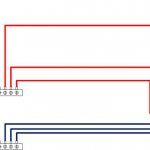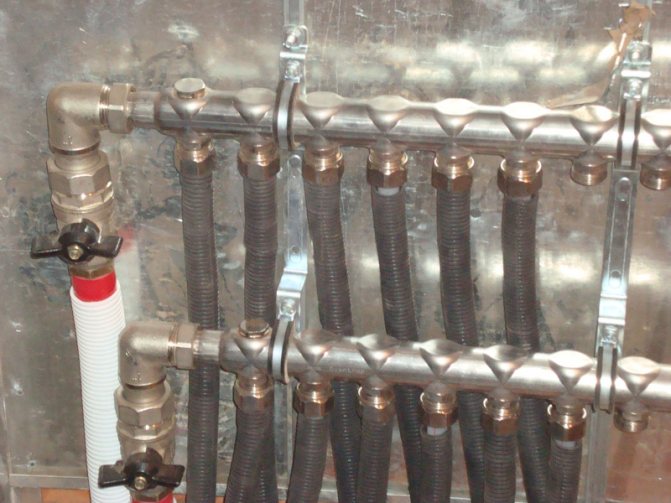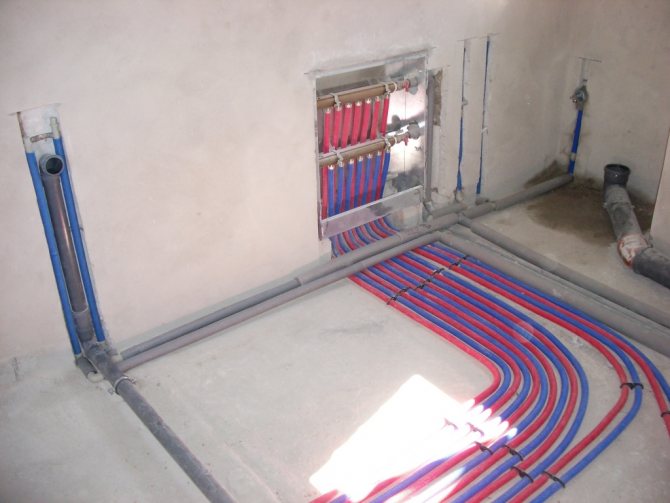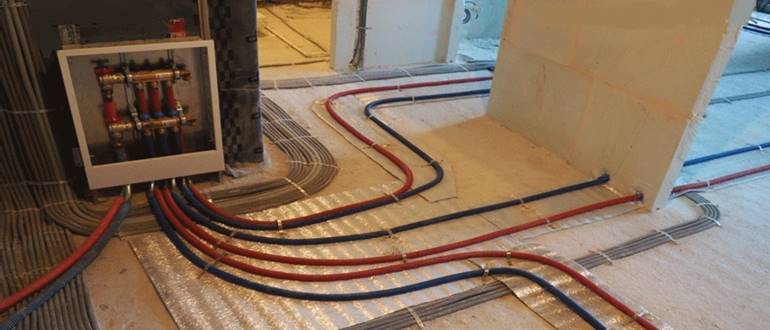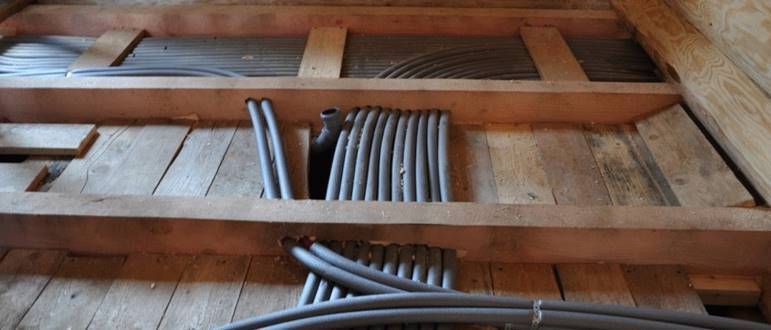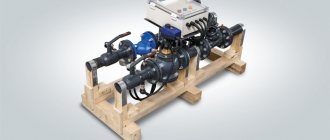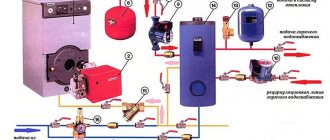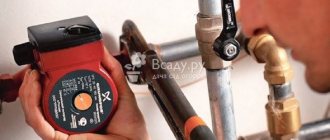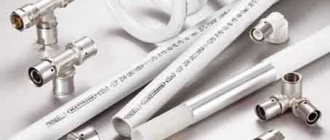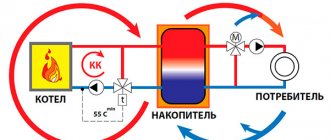Elements of the collector heating circuit
Radiation heating of a private house is a structure consisting of several main elements:
- Heating boiler
... This device is the starting point, since from it the hot coolant is directed to pipelines and radiators. The power of the heating unit must correspond to the heat transfer of the heating equipment. There is the following nuance: the radial layout of the heating system, in contrast to other options for laying the pipeline, has a greater degree of heat loss, which must certainly be taken into account when calculating the parameters of the equipment. - Circulation pump
... According to the peculiarity of its device, the radial heating distribution is of a closed type and for its functioning requires forced circulation of the heat carrier fluid. For this purpose, a special pump is installed that creates a certain pressure and pumping liquid. As a result, the required temperature regime is provided, which guarantees the efficient operation of the heat supply system.
When choosing a circulation pump for radiant heating, you should pay attention to a number of parameters, including the length of pipelines and materials for the manufacture of radiators. In addition, the power of the pump is not one of its most important characteristics; the speed at which the liquid will be pumped should be taken into account.
This parameter shows the volume of the coolant transported by the circulation device per unit of time.
In addition, the pump power is not one of its most important characteristics; the speed at which the liquid will be pumped should be taken into account. This parameter shows the volume of the coolant transported by the circulation device per unit of time.
Collector
(it is also called a comb). It is also an important element of the radial distribution of the heating system. The comb is assigned the function of a distribution device intended for centralized supply of heating radiators with a coolant (for more details: "Distribution comb of the heating system - purpose and principle of operation").
The radiant circuit of the heating system always contains a variety of thermostatic or shut-off and regulating elements. They provide the necessary consumption of the carrier of thermal energy in each branch of the structure. The installation of thermometers and air extractors operating in automatic mode will help create additional conditions for more efficient operation of the heating structure without unnecessary costs.
Collectors in the domestic market are offered to consumers in a wide range. The choice of a specific device is based on the number of projected heating circuits or connected radiators. Combs are made from various materials - it can be brass or steel, as well as polymer products.
Cabinets
... The radiant heating circuit requires that all the elements included in it be located in special structures equipped for them. Distribution manifold for heating. shut-off valves, pipelines must be placed in manifold cabinets with a simple design. They are both built-in walls in a niche and external ones, but at the same time they differ in functionality and practicality.

How to organize a ray system
The most important element in the organization of such systems is the collector assembly. If it is necessary to carry out wiring on each of the floors, you will need to place one on each of the floors.


Forced circulation pump
During the laying process, the collectors are placed in special cabinets, in which it is possible to regulate the operation of the system. When laying, it is required to ensure the minimum number of pipe joints, which significantly increases the safety and stability of the equipment.
Also, it is required to choose the right heating boiler, taking into account the power, heat and electrical energy costs, efficiency, taking into account the heat losses by the system. Regardless of the type of fuel that the boiler consumes during the heating process, the need for calculation is mandatory.
Choosing a forced circulation pump
The main application of the radial circuits of home heating systems is horizontal arrangement, with the supply of the coolant from the bottom. To ensure the possibility of functioning, it is required to use a circulation pump, which provides forced circulation of the coolant along the branches of the network.
The use of a pump can significantly reduce the temperature difference between the inlet and outlet at the circuit. As a result, the efficiency of the beam system is significantly increased, providing greater compactness and lower material costs.
There are several parameters to choose this type of unit:
- performance;
- head height.
To choose the right pump, you need to take into account the width of the pipe lumen, the length and level of height, relative to the pump itself. All calculations are made in advance.
Connection method without pump
The operation of the system can be ensured without purchasing and connecting a pump and a number of devices for removing excess air, but at the same time it is required to ensure that certain conditions are met, which are extremely difficult to implement. It is required to choose pipes with a large diameter and mount the expansion tank at the maximum height from the floor.
This method can be used in rooms with small dimensions to provide sufficient warmth in the room. However, the choice between forced or natural water supply is required even during the calculation process.
The rule is to mount a circulation pump
There is a number of recommendations for the correct installation of the pump:
- Wet power pumps are installed horizontally.
- The device with a thermostat must not be brought as close as possible to hot surfaces in order to avoid distorted readings.
- Installation is usually carried out on the return sections of the system in order to ensure the normal operation of the system in order to prevent exceeding the temperature indicators. A number of modern pumps can also be installed near the boiler and work without problems at high temperatures.
- If there is no mechanism for eliminating excess air on the heating circuit, you should definitely choose a pump with the ability to remove gases.
- It is advisable to mount it as close as possible to the expansion tank.
- Before installation, it is advisable to clean the system from all solid fractions.
- Before launching the radiation system, it is definitely worth conducting a preliminary test with water.


Circulation pump installation
Choosing a distribution manifold
This device has a second name - a distributor comb. It received it for its function - the supply of liquid that conducts heat to each individual heating element, radiators, warm floor and others. Also, the coolant is returned to certain holes on the way back, after which the boiler is supplied, or mixed with the contents of the pipes to reduce the temperature.
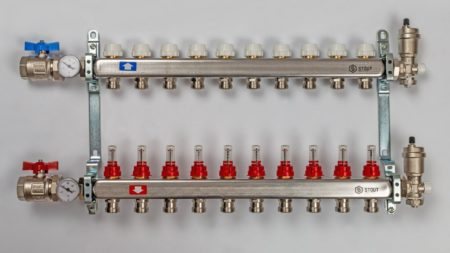

Distribution manifold
The number of simultaneously supported pipes reaches 12. In some models, for complex radiant heating systems of a two-story house, their number may be greater. Each manifold is activated by a ball valve, which allows the flow of fluid to be regulated to each radiator.This is necessary to adjust the amount of coolant that goes along the branches.
Choosing pipes
There are a number of aspects that determine the operational characteristics of the future pipeline. It is worth choosing after you decide where the network will be mounted: under a masking coating or in a cement screed.
In the process of work, it will be necessary to bend the pipes in a certain way, at a non-standard angle. For this reason, it is desirable to use a material with a sufficient degree of flexibility so as not to increase the number of joints. XLPE pipes are considered the best option.
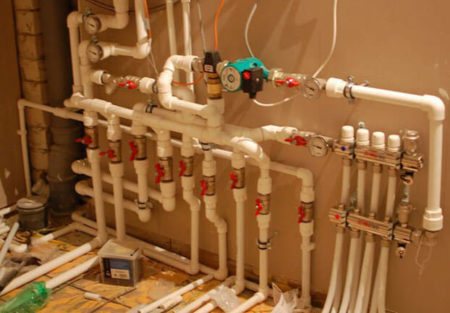

Pipes
Moreover, the structure must have a layer of airtight material. Otherwise, the smallest oxygen particles contained in the coolant may escape. As a result, rusting of the boiler and radiators is observed.
Also, you should pay attention to the following points:
- Radial routing does not require the use of standard diameter pipes. The optimal clearance is from 24 to 32 millimeters.
- It is worth choosing products that are sufficiently protected from mechanical damage. Most often, they are poured with cement, while it is required not to allow excessive pressure on the network.
This requires checking the integrity and connection of all pipe elements. Then you can start. This is required to prevent leaks during operation.
Manifold cabinets and blocks
In an apartment with horizontal radial heating distribution (on the floors of private houses), distribution manifolds (supply and "return") are arranged, collecting all supply and return pipelines at their exits. They are placed in metal cabinets of special design, often built into the partitions of sanitary facilities and opening inside them. Installation of distributor collectors in specially arranged wall niches is also possible. Quite often the collector unit is combined with the heat energy metering unit in one collector cabinet.
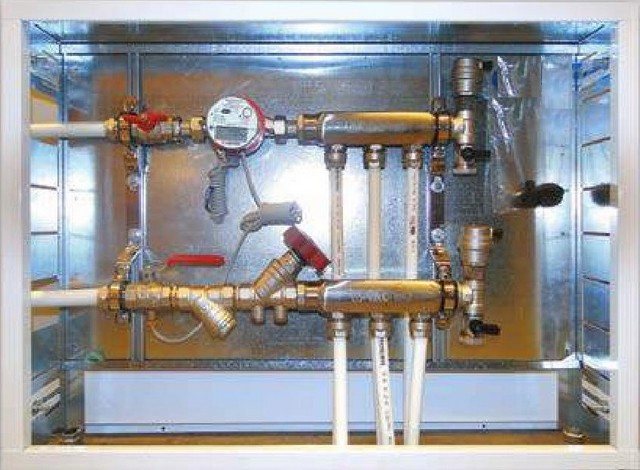

Manifold cabinet with heat metering unit.
Collectors can be complete, representing sections of thick pipes with branch pipes, or assembled on tees. The material for these devices can be:
- plastic;
- nickel-plated brass;
- copper;
- stainless steel.
Many well-known manufacturers of heating equipment (VALTEC, etc.) produce ready-made manifold blocks that combine supply and return manifolds, manual adjustment valves (on the supply manifold), thermostatic valves (on the return manifold), automatic air vents, drain valves and mounting brackets.
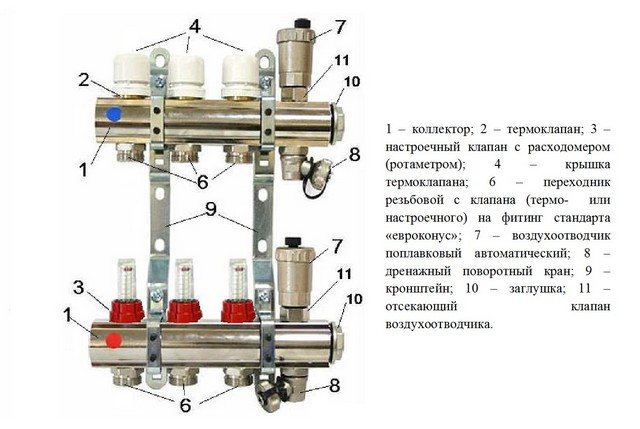

Complete manifold block.
The task of individual adjustment of the thermal regime of each single-radiator branch of the collector-beam heating system is solved by tuning valves with built-in flow meters. The branches are of different lengths, and the coolant tends to flow in the shortest path with minimum hydraulic resistance. It flows around short branches more intensively, warming up the radiators installed there more strongly.
Adjusting valves on the supply manifold change the flow of water (antifreeze), narrowing their nominal passages in short circuits, and expanding in long ones. Adjustment is a painstaking process, and the adjustment valve is not intended to quickly shut off or open the coolant flow through the circuits. This function is performed by thermostatic valves.
Thermal valves on the manifold - "return" - are valves that smoothly shut off the flow manually or automatically. The radiant heating system is easily hydraulically balanced.
Important points of installation
As a rule, in a private house a corresponding room is allocated for the boiler room, in which all the main elements of the heating system are located. The first stage in the installation of the system is the installation of the heating boiler.After the boiler is installed, the inlet and outlet manifolds are mounted. These elements of the system must be easily accessible. It is also necessary to install a Mayevsky valve on the outlet manifold.
In a radiant heating system, it is not recommended to combine a "warm floor" with a heating circuit on the same collector, since they have different operating temperatures.
Features of the radiant heating system at home
However, there is one more point that should not be overlooked. This is tuning or regulation. It is performed just in the regulation of the taps located on the manifold. But it should also be said that such a system is inconvenient because all the time it is necessary to regulate the modes, which is not always possible to afford purely physically. In addition, if you have a rather large building, then it is better to refuse this idea.
The bonfire is the first direct descendant of radiation heating, and the Russian stove is a vivid example of this. Large, occupying a significant amount of space, it was able to heat the house with its infrared radiation, or, in a simple way, with living heat. If the room is warm, then the radiation of heat, as such, does not occur, the person feels comfortable. And if there are cold walls, ceiling and other interior items in it, to a greater extent, it is on them that infrared rays emitted by a person are transmitted. Surely, anyone can remember the chills running through the body, it would seem, in a warm room. This is radial heat exchange, on the principle of which the radiant heating system of a house is built.
Overview of diagrams and components of the heating system
At the first stage, it is necessary to choose the principle of operation of the heating system. Even 20-25 years ago, there was practically no alternative - they made a gravitational open system. Therefore, the question of how to properly mount the heating was reduced to the choice of the diameter of the steel pipes and their correct slope. But the appearance on the market of the main elements of a closed system has significantly expanded the choice of a circuit.
Gravity heating system
Gravitational heating scheme
The main source of heating water for it is a solid fuel boiler (operation on a diesel engine or waste oil is possible). Installation of gas models is not possible, since their normal operation implies increased pressure in the pipes. Self-assembly of a heating system with a gas boiler is possible. But in this case, a solid fuel body is used, in which a special gas burner is mounted.
Before properly installing heating in a private house, you need to select its main components. In addition to the boiler, the following elements are mandatory:
- Pipes. For this type of heating, you can use plastic models (polypropylene, metal-plastic) or steel. It is best to choose a large diameter - from 40 mm. In this way, the total hydraulic resistance can be reduced;
- Expansion tank. It is necessary to stabilize the system in case of overheating of the coolant;
- Shut-off valves. Its installation is mandatory, since during repair or maintenance work, it will be necessary to shut off the coolant flow in a certain section of the system;
- Make-up unit. Required to add coolant. In order to optimize it, it is often included in the design of the expansion tank.
Radiator complete set for one-pipe heating system
The gravitational system in most cases is made one-pipe (Leningrad). In order to properly mount the heating radiator, it is necessary to install a bypass on each of them. This also needs to be taken into account when purchasing components and drawing up a general installation scheme.
In addition to these components, the installation of pressure gauges is required. If this device is not provided in the boiler design, it should be installed on the outlet pipe.
To mount a heating radiator, it is necessary to provide for the presence of a Mayevsky crane in it.It is necessary to eliminate air congestion in the system.
Forced circulation heating system diagram
Closed heating circuit with a solid fuel boiler
It is much more difficult to install a forced circulation heating system. The difference lies in the creation of increased pressure in the line. This contributes to an increase in the length of pipelines and an optimal temperature regime for the operation of the entire system.
The complete set of this scheme is best considered using the example of a solid fuel boiler piping. Since in most gas models, the overwhelming majority of the components are part of the structure (circulation pump, expansion tank, etc.). Therefore, in order to mount the heating system yourself, in addition to the boiler, the system must necessarily contain:
- Circulation pump. It will create the required level of coolant pressure;
- Closed expansion tank. Serves as a compensator when the pressure in the system rises above the critical one;
- Security group. Partially duplicates the functions of the expansion tank. If the pressure readings are too high, then the air vent and drain valve will reduce it, removing excess air and coolant from the system;
- Shut-off valves;
- Make-up unit.
How to mount a closed-type heating system yourself, and most importantly - which pipe layout to choose? Experts recommend installing a two-pipe one, since the radiators in this case will be connected in parallel, which will ensure an even temperature distribution throughout the system.
It is much easier to install a forced-type heating system than with natural circulation. In addition, the first is the only option for houses with a medium to large area.
What are the types of heating systems for an apartment building
Depending on the installation of the heat generator or the location of the boiler room:
- An autonomous system in an apartment, where the heating boiler is mounted in a separate room or in the kitchen. The costs of purchasing a boiler, radiators and related piping materials return quickly, since such an autonomous system can be adjusted based on your own considerations regarding the temperature regime in the house. In addition, the individual pipeline does not lose heat, but, on the contrary, helps to heat the premises, as it is laid through the apartment or around the house. An individual boiler does not need to be adapted for the reconstruction of centralized heating - once a heating scheme is drawn up and implemented, it will work for a lifetime. And, finally, an already working circuit can be supplemented with parallel or series-connected circuits, for example, a "warm floor";
- The option of individual heating, which is designed to service the entire apartment building or the whole residential complex, is a mini-boiler room. An example is the old boiler houses serving the block, or new complexes for one or more houses on different sources of energy - from gas and electricity to solar panels and thermal springs;
A centralized heating scheme in a multi-storey building is the most common working solution to the problem so far.
Heating schemes depending on the parameters of the working fluid:
- Heating with ordinary water, in the pipes of which the coolant is not heated above 65-70C. This is a development from the field of low-potential systems, but most often old schemes work with a working fluid temperature reaching 80-105C;
- Steam heating, where not hot water moves in pipes, but steam under pressure. Such systems are a thing of the past, and today they are practically not used in the delivery of heat and heating of any type of apartment buildings.
Based on the piping diagram:
- The most common is a one-pipe heating system for a multi-storey building, where both supply pipes and return pipes are one thread of the heating main. Such a scheme can still be found in "Khrushchev" and "Stalin" buildings, but in practice it has a big drawback: batteries or radiators connected in series in the circuit do not provide uniform heat transfer - each next heating device will be slightly colder, and the last radiator in the pipeline will be the coldest. For at least approximately the same heat distribution throughout the rooms, each radiator next in the circuit must be equipped with a larger number of sections. In addition, in a one-pipe heating scheme in a five-story building, it is impossible to use radiators that do not correspond to the design parameters, and devices for adjusting heat transfer - valves, etc. regulation;
- The Leningradka scheme is a more perfect solution, but according to the same one-pipe scheme. In this scheme, there is a bypass (pipe jumper) that can connect or disconnect additional heating devices, thereby regulating heat transfer in the room;
A more advanced two-pipe heating system in an apartment building began its existence with the construction of buildings according to the project of the so-called "Brezhnevka" - a panel house. The supply and return flow in such a scheme work separately, so the temperature of the working fluid at the inputs and outputs of apartments in a 9-storey building is always the same, as in radiators or batteries. Another plus is the ability to install a regulating automatic or manual valve on each heating device; The beam (collector) scheme is the latest development for atypical housing. All heating devices are connected in parallel, and taking into account the fact that this is a closed OO system in an apartment building, the piping can be made hidden. When implementing the beam scheme, all adjusting devices can limit or increase the supply of heat in a metered manner.
Collector selection
The radiant heating system includes a collector (comb). This element looks like a pipe. It has nozzles for the inlet and outlet of the coolant. For the beam scheme, two types of collectors should be installed.
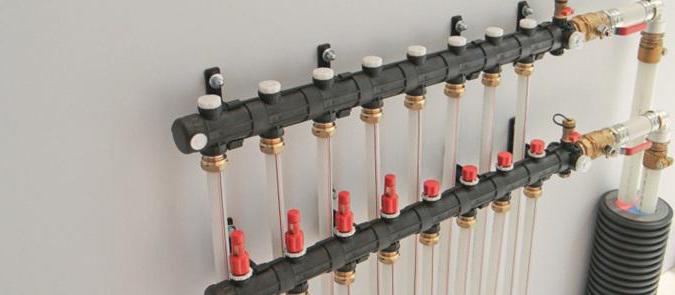

The first of these will be the inlet comb. A pump is connected to it, as well as a coolant distribution valve. It can be three- or two-way. The valve includes a thermometer. It is installed in the collector housing. The device transmits information to the valve. It opens or closes the damper, mixing hot liquid into the circuit.
The outlet collector collects the cooled heat carrier, which is returned to the boiler. The heater heats it up again. Additionally, a balancing flow controller can be installed on this branch pipe. The collector group ensures the stability of the system. She is responsible for optimizing and balancing the heating of the coolant in the system.
Advantages and disadvantages
The radial distribution of the heating system has the following advantages over the tee:
- supply of coolant to all radiators of the same temperature;
- fast circulation of the coolant allows you to quickly warm up the whole house;
- the ability to maintain and repair one radiator while maintaining the functionality of all the others;
- the ability to set a separate temperature regime for each room and quickly manage this regime;
- the absence of hidden connections reduces the risk of leaks under the floor or in the walls;
- hidden installation of pipes improves the aesthetic impression produced by the interiors;
- convenience and speed of installation of the system.


The radiant heating system is convenient and quick to install
There are also disadvantages to such a wiring diagram:
- high cost of materials and equipment;
- the total length of the pipes is several times higher than with the tee scheme;
- additional area (or a separate room) is required to accommodate collectors on each floor.
In general, the higher cost of materials and installation quickly pays off in savings and ease of use.
Single pipe horizontal
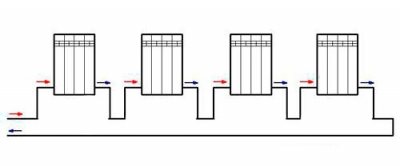

The simplest version of a one-pipe horizontal heating system with bottom connection.
When creating a heating system for a private house with your own hands, a single-pipe wiring scheme may be the most profitable and cheapest. It is equally well suited for both one-story houses and two-story houses. In the case of a one-story house, it looks very simple - radiators are connected in series - in order to ensure a consistent flow of the coolant. After the last radiator, the coolant is sent through a one-piece return pipe to the boiler.
Advantages and disadvantages of the scheme
To begin with, we will consider the main advantages of the circuit:
- ease of implementation;
- great option for small houses;
- saving materials.
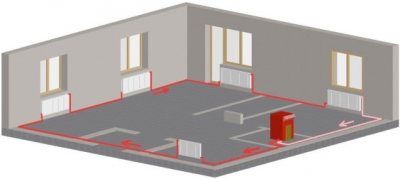

A single-pipe horizontal heating scheme is an excellent option for small rooms with a minimum number of rooms.
The scheme is really very simple and straightforward, so even a beginner can cope with its implementation. It provides for a serial connection of all installed radiators. This is an ideal heating wiring diagram for a small private house. For example, if it is a one-room or two-room house, then it does not make much sense to "fence" a more complex two-pipe system.
Looking at the photo of such a circuit, we can note that the return pipe is one-piece here, it does not go through the radiators. Therefore, such a scheme is more economical in terms of material consumption. If you do not have extra money, such a layout will be the most optimal for you - it will save money and allow you to provide the house with heat.
As for the shortcomings, there are few of them. The main disadvantage is that the last battery in the house will be colder than the very first one. This is due to the sequential passage of the coolant through the batteries, where it gives off the accumulated heat to the atmosphere. Another disadvantage of a one-pipe horizontal circuit is that if one battery fails, the entire system will have to be turned off at once.
Despite certain disadvantages, such a heating scheme continues to be used in many small private houses.
Features of installation of a single-pipe horizontal system
Creating water heating for a private house with your own hands, a single-pipe horizontal wiring scheme will be the easiest to implement. During the installation process, it is necessary to mount the heating batteries, and then connect them with pipe sections. After connecting the very last radiator, it is necessary to turn the system in the opposite direction - it is desirable that the outlet pipe runs along the opposite wall.


A single-pipe horizontal heating scheme can also be used in two-story houses, each floor is connected in parallel here.
The larger your home, the more windows it has and the more radiators it has. Accordingly, heat losses also increase, as a result of which it becomes noticeably cooler in the last rooms. You can compensate for the drop in temperature by increasing the number of sections on the last radiators. But it is best to mount a system with bypasses or with forced circulation of the coolant - we will talk about this a little later.
A similar heating scheme can be used to heat two-story houses. For this, two chains of radiators are created (on the first and second floors), which are connected in parallel to each other. There is only one return pipe in this battery connection diagram, it starts from the last radiator on the first floor. A return pipe descending from the second floor is also connected there.
Installation features
Any radial heating system for a dwelling is designed and installed individually, depending on the area of the house, the number of rooms, the selected heat carrier and radiators, as well as other conditions.
However, there is a generally accepted instruction that every installer follows.
First of all, it should be noted that radial piping is never done in city apartments. This is due to the fact that the supply of coolant in high-rise buildings is carried out through vertical risers connecting all apartments - from the first floor to the last.


It is impossible to install a collector in an apartment, since the upper floors will remain without heating
As a result of connecting powerful collectors, hot water will not reach the rooms located above, which will disrupt the operation of the heating network. Residents will complain to the service organization, which, sooner or later, will force you to dismantle the collectors and return to the tee heating system.
Note! The above does not apply to cases when an autonomous boiler is used to heat the apartment. He independently heats up the coolant, which will be enough to meet the needs of the home, without affecting the interests of neighbors.
When arranging radiant heating in a private house, you need to pay attention to the following nuances:
- On the collectors that supply and drain water for the batteries, valves must be installed to prevent the formation of air locks. During operation, all the air remaining in the system will escape through them to the outside.


On return pipelines, valves must be installed to bleed air.
- The heating circuit must be equipped with an expansion tank, the volume of which is 10% of the amount of heat carrier circulating through the pipes. It is advisable to buy closed-type membrane containers.
- It is advisable to mount the tank on the pipeline that connects the outlet manifold to the boiler. This is due to the fact that a sealed expansion tank does not like turbulent water flows, and they are least likely to appear on the return line.
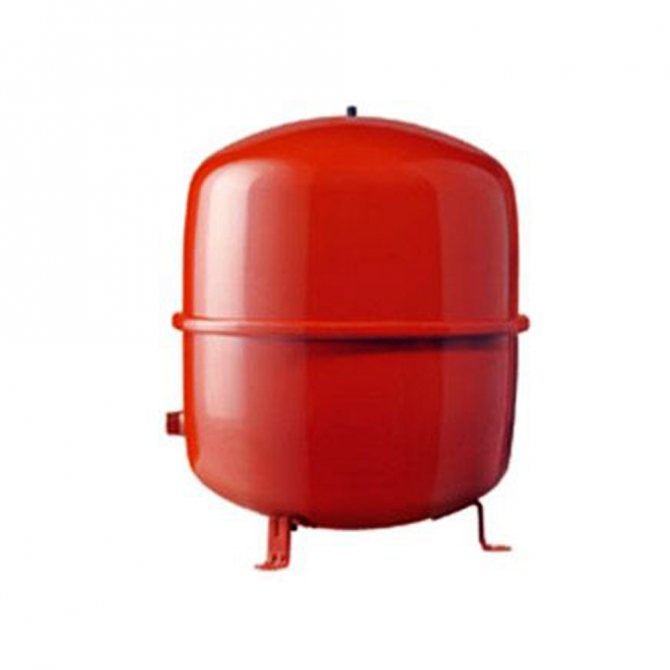

In the photo - a membrane-type expansion tank for a heating system
- Unlike the expansion tank, the location of the circulation pumps is not so important. But it is also advisable to connect them to a pipe that removes the cooled coolant. In this case, the equipment will work for a longer amount of time.
- During installation, care must be taken to ensure that the shafts of the electric pumps are positioned strictly horizontally. Otherwise, due to distortions, the bearings will quickly fail, and you will have to change or repair the equipment.
Radiant heating system for two-story house is the best choice
At the moment, it is simply not possible to find a more efficient and economical floor heating system for two-story private country houses than a two-pipe beam scheme. Having correctly selected the equipment, as well as having calculated all the nuances and performing the installation, as required by the instructions, you can ensure comfort and coziness in the house.
It is important to point out the fact that traditional radiators are the main heating devices in a radial double-circuit system. Regardless of the size and material (and it can be both cast iron and aluminum), such units must be installed correctly:
Regardless of the size and material (and it can be both cast iron and aluminum), such units must be installed correctly:
- Heating batteries must be installed only under window openings;
- All radiators must be installed at the same height;
- The ribs of the battery are located only vertically - otherwise, normal circulation of the coolant will be impossible;
- It is imperative to provide a drain system through which the coolant will be replaced.
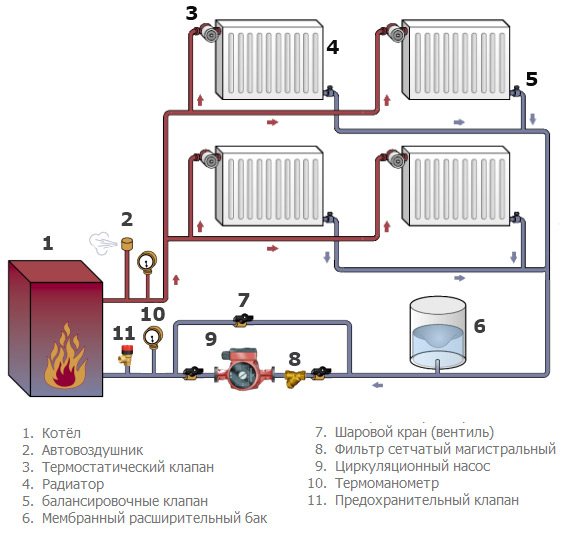

Two-pipe heating system for a house with two floors
A boiler also means a lot (see how to choose a gas heating boiler)
For the normal operation of a two-circuit system, it is important to choose modern and efficient boilers. Such a technique (and even equipped with automation) will make it possible to ensure optimal heating of each room of a two-story house, significantly saving fuel and finances and getting hot water
The heating system of a two-story building of a two-pipe radiant heating circuit is not only quite efficient and effective, but also demanding for the first start-up.
So, for example, before starting direct operation, it is important to correctly balance the system, adjust the fluid flow for each loop of the supply and return pipelines. This is the only way to achieve fuel economy, ensure the highest possible heating level
General requirements for the installation of beam wiring
With collector-beam wiring, it is common to lay pipes in the floor in a screed, the thickness of which is 50-80 mm. Plywood is laid on top, covered with a finishing floor covering (parquet, linoleum). This thickness of the screed is quite sufficient for free "monolithing" of the intra-apartment (intra-house) radial distribution of the heating system. It is possible to lay pipes outside along the walls under decorative skirting boards, which will inevitably increase the length of the pipelines. Known options for laying pipes for beam wiring in the space of the hemmed (suspended) ceiling, in the grooves.
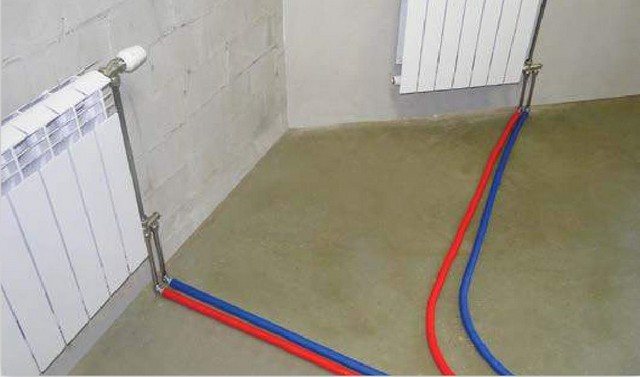

Connecting radiators with a collector-beam scheme.
Used metal-plastic or cross-linked polyethylene pipes (PEX-pipes), laid in a corrugated pipe or in thermal insulation. PEX pipes have an undeniable advantage here. According to SNiP, only permanent joints can be “monolithic” into concrete. PEX pipes are connected by means of tension fittings, which are permanent connections. Reinforced-plastic pipes use compression fittings with union nuts. "Monolithing" them means violating SNiP. Each detachable pipe connection must be accessible for maintenance (tightening).
Even without fittings, not every metal-plastic pipe is uniquely suitable for laying in a floor screed. Manufacturers' products suffer from a serious defect: layers of aluminum and polyethylene delaminate under the influence of the repeatedly changing temperature of the coolant. After all, metal and plastic have different coefficients of volumetric expansion. Therefore, the adhesive connecting them must be:
- internally strong (cohesive);
- adhesive to aluminum and polyethylene;
- flexible;
- elastic;
- heat resistant.
These requirements are not met by all adhesives, even of well-known European manufacturers of metal-plastic pipes, which delaminate over time, the inner layer of polyethylene in such a pipe "collapses", reducing its cross-section. The normal operation of the system is disrupted, and it is almost impossible to find the place of the malfunction - usually they "sin" on malfunctions of thermostats, pumps and other products with moving parts.
In light of the above, we recommend that readers pay attention to the VALTEC metal-plastic pipes, which use the American glue of the DSM concern, which ensures the strength of the metal / plastic connection, adhesion and the complete absence of delamination.
Modern heating systems
A fairly large amount of time has passed since the Russian stove, and although it is an ideal option for radiant heating at home. but at the present time, installing it in a city apartment is nonsense.But technologies are also developing every day, so all heating systems, including radiant ones, installed both in private houses and in apartments, are mostly the most modern and adapted to the needs of each person.
Heating systems, first of all, are divided according to how the pipes are supplied from the collector to the radiators. These are several types of systems, such as;
- One-pipe;
- Two-pipe;
- Beam;
The principle of radiant heating is that the wiring from the collector, the main distributor of the coolant, is meant for each radiator separately. This is the most significant plus in this system - radiators can be turned on and off, either individually or as a group.
In addition, the heat supply valve can be adjusted. For example, if the kitchen does not require such an amount of heat radiation, due to the work of household appliances that serve as an additional source of heat, then the valve can be screwed on. This can be done so that heat flows into the kitchen, but not in the same amount as in other rooms. The same can be done with those rooms that are not used for their intended purpose, but the heat should be retained in them. By regulating the supply of heat, fuel economy is also increased. and due to this, the readings of the heat meter are also pleasing.
Underfloor heating system
As many may have noticed, a radiant heating system is mounted on the same principle as a water-heated floor. In theory, it is possible to connect a warm floor with radiators through one comb. This method will be especially in demand by those who want to install underfloor heating in some rooms, and radiators in others.
If you build a radiant system with underfloor heating, it will work. But keep in mind that underfloor heating is a low-temperature system, and radiators are a high-temperature system.
If you do not think over the temperature control, then in one case it will be hot with warm floors in the room, in the other case it will be cold with radiators. Keep this in mind.
There is one more side positive property of the collector heating system. Namely, a comfortable warm floor. The fact is that when radiant heating systems are mounted, the distributor is mounted closer to the risers or the center of the room. In this case, the pipelines from the distributor to the radiator in 99 percent of cases pass through corridors, enter rooms through doorways.
Yes, pipes in this case are insulated with pipe insulation in one layer. But many installers know that 6-9 mm insulation allows up to 30 percent of heat to pass through.
That is why, where the pipes of the radiant heating system of the house pass, the floors are not cold, but comfortably warm. With one heating system, we catch two birds with one stone. We get a reliable heating system without joints in building structures and comfortable warm floors.
How is a multi-storey building heated?
- The principle of operation of the elevator unit
- About the heating system of a multi-storey building
The heating system of a multi-storey building is of particular interest, it can be considered on the example of a standard five-story building. It is necessary to find out how heating and hot water supply functions in such a house.
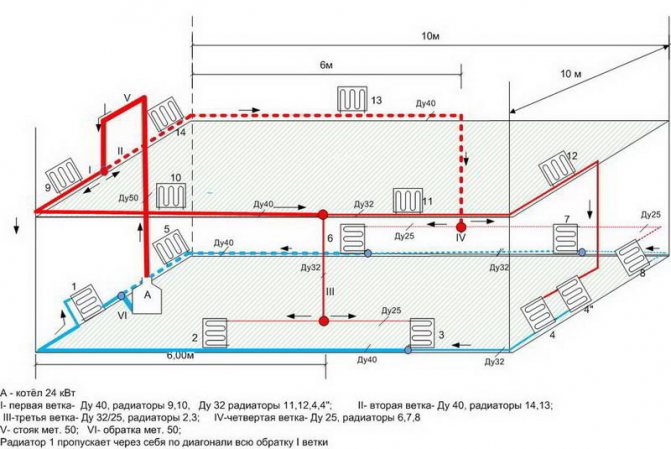

Heating scheme for a two-story house.
The five-storey building has central heating. the house has a heating main, there are water valves, there may be several heating units.
In most homes, the heating unit is locked in order to achieve security. Despite the fact that all this may seem very complicated, the heating system can be described in simple terms. The easiest way is to take a five-story house for example.
The heating scheme of the house is as follows. After the water valves, there are mud traps (there may be one mud trap). If the heating system is open, then after the mud collectors, valves are located through the tie-ins, which stand from processing and supply.The heating system is made in such a way that water, depending on the circumstances, cannot be taken from the back of the house or from the supply. The thing is that the central heating system of an apartment building operates on water that is overheated, water is supplied from a boiler room or from a thermal power plant, its pressure is from 6 to 10 Kgf, and the water temperature reaches 1500 ° C. Water is in a liquid state even in very cold weather due to the increased pressure, so it does not boil in the pipeline with the formation of steam.
When the temperature is so high, the hot water supply is switched on from the back of the building, where the water temperature does not exceed 700 ° C. If the temperature of the coolant is low (this happens in spring and autumn), then such a temperature cannot be sufficient for the normal functioning of the DHW, then the water for the DHW comes from the supply to the building.
Now you can disassemble the open heating system of such a house (this is called an open water intake), this scheme is one of the most common.
Analysis of the arguments "for" and "against"
Let's start with the cons. In addition to material consumption, which affects the cost of the project, there is the need to install a manifold cabinet, which will require additional space.
This is where the disadvantages of the ray system end, and a ridge of advantages begins:
- simple design and installation, pipes of the same diameter are used within the system;
- with hidden installation, there are no connections in the walls and floor;
- high speed of installation due to the minimum number of connections;
- expansion of functionality through the installation of valves, sensors, air vents and thermal heads to automate the operation of the heating system;
- temperature control in each individual room using mechanical elements or automation;
- the ability to cut off any radiator without stopping the heating process;
- uniform heating of all rooms.
The external control panel allows you to program the heating operation, including automatic adjustment depending on the weather conditions outside. Thanks to the installed sensors, all residents can set any parameters that are comfortable for them, being in a particular room.
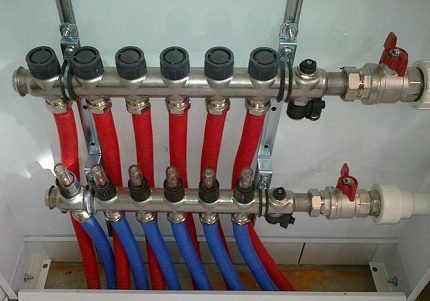

The radiant system is materially costly in terms of implementation, but is ahead of all other options in terms of flexibility of settings and ensuring the efficiency of all heating
Thus, the radial layout of the wiring allows you to achieve high controllability of the heating system and achieve the optimal flow rate of the coolant.
Types of radiant heating system
A visual diagram of a heating system in a private house.
A radiant heating system in a private house can be installed with both forced and natural circulation of the heat carrier. Currently, the natural circulation system is used very rarely, since it requires the use of pipes with a very large diameter, which is not very convenient for a private house. In addition, this system is equipped with an expansion tank, the installation of which is necessary at the highest point of a two-story house, which, again, is not very convenient. But at the same time, a radiant heating system with natural circulation will help save on installation, since it does not require additional expensive equipment (pumps, temperature sensors, air vents, etc.).
The collector heating system with forced circulation is the most widely used; its main advantage is the artificial circulation of heat through pipes. For these purposes, a special pump is installed in the supply or return line. Forced circulation makes it possible to reduce the temperature difference between the inlet and outlet water, and also simplifies the heating system itself, which makes it more compact and helps to avoid unnecessary waste of materials.This heating system is absolutely independent of the project of the house and the location of the heated rooms in it. The hydraulic resistance of the pipeline and the length of the branches do not play a special role. And due to the installation of modern automatic devices, you can change the temperature depending on the weather conditions and the individual wishes of the residents. All these advantages make this system universal.
Selection of pipes for the heating system
The most common for the installation of heating systems in two-story houses are metal-plastic pipes. This is primarily due to the fact that no sludge is deposited on products made of polymeric materials and they are resistant to corrosion. Quite low price is another advantage of metal-plastic pipes. All connections are made without the use of welding using threaded or press connections, which maximally simplifies installation. Nevertheless, such pipes have one drawback - a high coefficient of thermal expansion, which, if used improperly, can lead to leaks.
Pros and cons of a radiant heating system
The disadvantages of radial heating in the house include:
- a large number of materials and, as a result, a higher cost;
- the need for a special place for the manifold block.
The advantages of the beam system are:
ease of installation due to the small number of connecting elements; hidden pipe laying in the floor; hydraulic stability, which is especially important when using imported sanitary ware; the ability to turn off each radiator separately, while all the others work as usual; temperature control in each individual room; balanced system, all rooms are heated evenly.
When developing a project for a radiant heating system, it is necessary to detail it as much as possible, this will greatly simplify the installation and help to avoid problems in the future. It should also be noted that the actual costs will always exceed the planned ones, this must be taken into account when drawing up the estimate. But, in spite of everything, the radiant heating system is highly efficient and capable of creating maximum comfort in the living space.
Pros and cons of the beam system
It is best to weigh all the pros and cons before installing the heating system and decide in advance which system will suit you best. Of course, the ray system has its own characteristics, which must also be taken into account.
Benefits of the beam system
But all of the above is losing its significance against the background of the general merits of the radiant-type heating system. In a very short period of time, a properly designed and installed beam system:
- It will pay for itself with interest. It also has a lot of useful and convenient features;
- When using a radiant heating system, it is possible to differentiate the approach to heating in each room. This approach allows you to more efficiently distribute heat in your home, which entails very large energy savings;
- This system is also convenient in that during its repair, you can get unhindered access to pipe connections, which speeds up the identification of problems and their elimination;
- In a traditional heating system, it is not very easy to hide pipes. The beam system allows pipes to be hidden from view either in walls or under floors. If this system is installed correctly, then no nodes and wiring will be conspicuous;
- The correct radial layout allows you to effectively distribute heat throughout the entire area of your home.
Cons of the beam system
- This system has, perhaps, only one drawback - it is a greater number of elements in its design. In particular - pipes. It also uses more fittings;
- The large number of elements in a given system can increase repair costs.A conventional heating system has a lower estimated cost and is cheaper to repair.
The radiant heating system of a private house requires a more correct approach when connecting all heating devices, since violation of the connection rules are fraught with frequent breakdowns of the system as a whole.
Varieties of beam wiring
Method 1.With forced water circulation
Previously, a radial heating system equipped with pumps that pump water was not very popular due to the high cost of parts. But now the price of equipment has dropped significantly, and more and more people are choosing it.
The main difference from the gravitational scheme is that liquid (water or antifreeze) flows from the boiler to the batteries and back not due to the difference in temperature and pressure, but with the help of pumps.
This achieves the following advantages:
- there is no limit on geometry and number of rooms in housing construction;
- heating can be installed in any area of the premises;
- to connect radiators and collectors, you can use pipes of any length, laid without a slope.
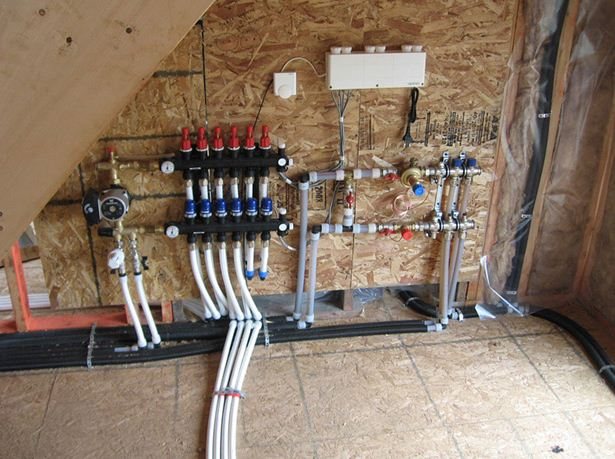

One of the elements of a radial heating system with forced circulation is a pump
Advice! Despite the fact that the circulation pump can be installed at any point in the system, it is advisable to do this on the return manifold before supplying the coolant to the boiler. There, the temperature of the liquid is the lowest, which has a positive effect on the service life of the equipment.
Method 2.With natural water circulation
In this case, the coolant moves due to gravity: the heated water becomes less dense and lighter, therefore it is displaced to the upper point of the system, after which, as it cools, it flows through the collectors and radiators, and then returns to the heater.
The gravitational beam heating system has the following features:
- Installation requires an open expansion vessel at the highest point. It compensates for the thermal expansion of the coolant and prevents an increase in internal pressure in the pipelines.
- The natural circulation radiant heating network does not require the installation of expensive electrical equipment, which significantly reduces the estimated cost of the work.
- Natural circulation heating is completely non-volatile. Even with a power outage, which often happens in summer cottages or in rural areas, you will not be left without heat.
The gravity heating system does not use pumps
Radiation pipe layout
The collector (radial) heating system has its positive aspects, such as simplicity and stability of operation. When there is an opportunity to use it, then experts give preference to just this arrangement of pipes without hesitation.
What is the beam scheme
In the collector circuit, each radiator is connected with long pipelines to one distribution header - hence the name of the system.
The origin of the second name "ray" - long beams of pipes diverging from one center in different directions to the radiators.
The collector itself is connected directly to the boiler, to the mains.
In the simplest systems (up to 4 radiators), the collector can be replaced with several tees lying on the base (in a heat insulator), and balancing can be done on radiators, which can be of different designs and connected in different ways.


How is balancing done
Balancing taps are more often installed on the collector - with the help of them, the flow rate of the coolant is adjusted so that the temperature of the radiators is approximately the same.
If the beams are of approximately the same length, then balancing is not needed at all.With a significant difference in the length of the connections, such valves are placed on the shortest branches so that it is possible to raise their hydraulic resistance, and thus equalize the flow rate across all devices.
On the radiators themselves with an automated boiler, it is possible to install thermal heads - regulators that automatically maintain the desired temperature in the room, which is convenient for users.
With a boiler without automation, such equipment, which independently blocks the movement of the coolant, cannot be installed in the system.
In addition, shut-off valves are installed on the radiators, which ensure the possibility of repair. The same valves are installed on the manifold, if balancing valves are not installed.
Diagram of connecting a collector for 3 radiators to the heating system, radiators of various types ...
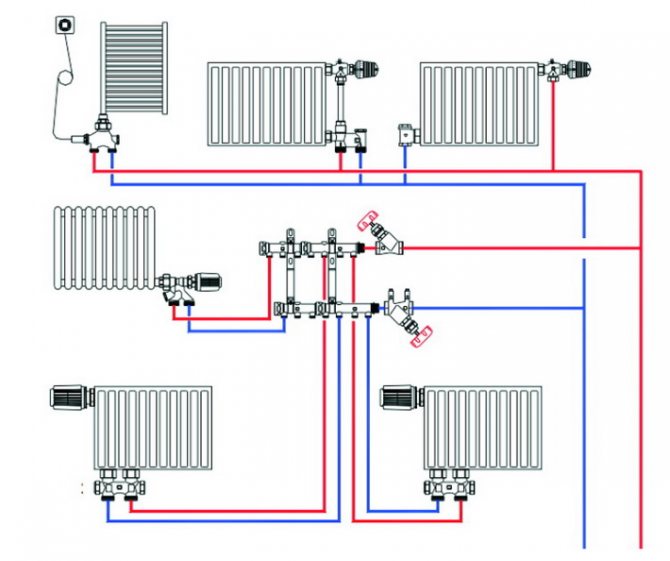

Where can the beam scheme be applied?
The scope of the beam scheme is limited. The following conditions must be met.
- Possibility of laying pipelines under the floor or under the ceiling sheathing (for the second floor). The system is made at the stage of construction or overhaul, before the sewing (filling) of the floors.


- The possibility of installing a collector in the central part of the house. If the difference in the lengths of the connections is more than 3 times, then the balancing must also be very deep. This entails a general increase in the hydraulic resistance of the system, excessive consumption of electricity, and the installation of more powerful pumps. In such cases, it is more profitable to abandon the beam scheme.
But the situation when it is possible to lay pipes under the floor and install a collector in the center is often encountered. Therefore, the collector circuit is often used.


Floor convectors are usually radially connected. More about underfloor heating devices
Decide on the type of radiators
A room in which the radiators are connected from the bottom and the pipes are hidden under the floor is aesthetically pleasing. But at the same time, you need to decide on the type of radiators and connecting unit. The option recommended by specialists is complex radiators with a bottom connection and a built-in upper thermal head. But these are expensive options.


It is possible to supply a "normal" radiator with different connection points.
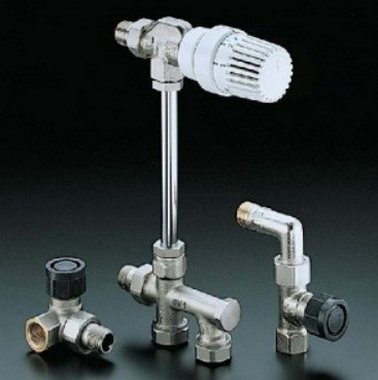

There are connecting nodes with a lower thermal head, options with an upper regulator. It can be used without a thermal head but with shut-off (balancing) valves. In the beam scheme, minimalism is acceptable and efficient - only the connection unit is on the radiator, and the balancing taps are on the collector.
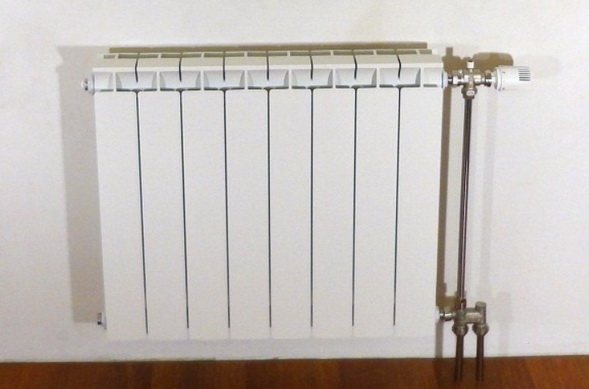

Another option is conventional radiators connected diagonally (supply from above, return from below) with conventional piping with taps and a thermal head.
What pipes and fittings are used
Only solid pieces of pipes should be under the floor. For laying, metal-plastic pipes supplied in coils, as well as polymeric multilayer PEX and PERT with an oxygen barrier can be used. But experts agree that metal-plastic with an aluminum layer is the most reliable option both in terms of strength and resistance to oxygen penetration.
To avoid large leftovers from the bays, it is advisable to calculate in advance all the lengths of the highways, then pick up the bays in the store. The purchase of bays of 50 meters, as a rule, entails extra costs.


It is possible to leave only crimping tees for metal-plastic under the casing, if necessary, which experts call "eternal". Direct joining of pipes is not allowed.


Applicable diameters
As a rule, a system that includes up to 5 radiators is connected from the boiler (from the branch line) with a diameter of 20 mm for metal-plastic. If there are 5 or more radiators, then 26 mm will be required (32 for polypropylene), but the area heated from the collector should not exceed 120 - 150 square meters.
If the area is more than 120 square meters, then, most likely, large diameters of the collector connection will be needed, but this is already being analyzed by specialists, calculations are being made.
Each radiator from the collector is connected with 16 mm metal-plastic pipes, as a rule. In some cases, when the lengths of the beams are more than 40 meters, it is recommended to make them with a diameter of 20 mm in order to reduce the total hydraulic resistance.
For example, a hydraulic connection diagram for a collector system. Applied 26 mm (from the boiler), 20 mm for the manifold, 16 mm for the radiator.


Installation features
Hidden laying of pipes entails an obligatory additional condition - their thermal insulation. Heating wiring can heat up to +80 and +90 degrees C. The impact of such temperatures on both wooden elements and the screed is not desirable. A thermal insulation barrier should be installed to reduce the rate of heat transfer so that it has time to be dissipated by the structure. On sale you can find special covers made of foamed polyethylene for hidden pipe laying.


For the installation of metal-plastic, certain skills are required. It is critically important to properly prepare the end of the pipe with calibrators before installing it on the fitting seal. As a rule, crimp (more reliable) fittings are used, the connection of beams with fittings on radiators and collectors is not made collapsible.
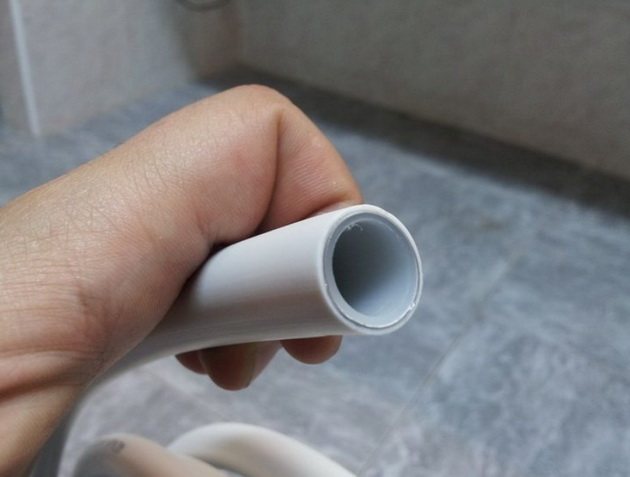

The procedure for mounting the beam scheme
First, radiators are installed in all rooms. Their position, as a rule, at the same level is verified with a level (water level). Tilt - elevation towards the Mayevsky crane or horizontally. The power of the devices is selected according to the heat loss - how to choose radiators according to the power On the radiators, plugs are installed that connect the nodes (bottom connection) of the thermal head, taps to which transition fittings are connected to metal-plastic.
The collector box is installed and the collector is mounted. Usually, the simplest and cheapest distributors are selected, equipped with shut-off (ball) valves with 16 mm outlets and 3/4 connection. The image shows a manifold complete with air vents and a pressure gauge.


Fittings for metal-plastic are installed on the collector - American.


The connection of the collector itself to the boiler (to the tees of the pipeline from the boiler) can be either hidden under the floor or along the walls. After that, the collector is connected by a pair of beams - "supply and return" 16 mm with each heater.


For self-installation, when it is not possible to use crimping pliers, and, accordingly, crimping fittings, you can also install compression fittings, while the installation itself is performed with ordinary keys. The use of such fittings in this system is possible, since they are open for control and are available.
Beam layout features and elements
The most optimal heating system using radiation is suitable, especially for apartment buildings, or private houses with more than one floor and many rooms. This significantly increases the efficiency of the operation of all equipment as a whole, guarantees high-quality heat supply and significantly reduces the amount of heat and energy indicators.
The principle of operation of the radiant heating system is quite simple, but it has some peculiarities. For example, if the building has several floors, then the installation of a collector is implied on each floor. Moreover, in many cases, not one, but several collectors are installed, and piping is already from them, and the organization of direct and reverse supply of the coolant. It is also worth noting the fact that radiant heating of a house works effectively only if the house is well insulated. due to which the least heat loss occurs. If the house is insulated from the inside. and outside - there will be no problems with heating based on the principle of infrared radiation.If, on the contrary, all the heat will go to heating walls, window panels, floors, and so on.
But by itself, a radiant heating system is a complex design. combining basic and additional elements necessary for high-quality work. This can include;
- Boiler. which is almost the main element. It is from it that heat is supplied to the pipes, and through the pipes to the radiators.
- Circular pump. which creates a certain pressure in the pipes, with the help of which the coolant circulates, and the optimum comfortable temperature in the premises is maintained. It also guarantees the efficient operation of the entire heating system;
- The collector (or in another way - the comb) is another most important element in the radial heating system. It is, as it were, central, and it is from it that the uniform supply and distribution of heat to all rooms of the house comes;
- Cupboard. where all heating elements must be hidden. The manifold cabinet hides the distribution manifold itself. pipes and valves. It is a fairly simple design, but very functional and practical. They can be located both outside and built into the wall;
Differences from a two-pipe system


Two-pipe heating system
Autonomous heating systems are becoming more and more popular among the people. They have a lot of all kinds of wiring options. Until recently, conventional autonomous heating systems were used, but more recently they were replaced by radiant systems. They are also popularly called collector ones. The name speaks for itself, since individually each radiator is connected directly to the manifold that distributes the coolant. With this connection of radiators - they are completely independent of each other. In a radiant heating system, other heating devices can also be used, which also do not depend on radiators in this system. The radiators are here connected in parallel with the manifold. As a rule, the collector is mounted somewhere in a remote part of the room, or hides in a wall, or in a special cabinet. The collector is sometimes quite large. It all depends on the area of the heated room. The beam system makes it easy to repair a broken radiator without stopping the entire system. The radiator requiring repair should simply be disconnected from the heating system and dismantled.
In a conventional heating system, a two-pipe system is used. It is also called tee. For the installation of this scheme of autonomous heating, much fewer pipes are required than for radial. But the additional costs of pipes in a ray system are more than compensated by energy savings. The radiant heating system most clearly reveals its economic effect in residential premises with a large area, especially in multi-storey private buildings.
What is the difference between tee wiring and radial
Such installation is quite complex, which increases the risk of breakdowns in the event of installation errors or sudden pressure drops in the heating system.
Beam layout
Radiant heating system involves laying pipes from each radiator to a special distribution device - a collector or, as it is also called, a comb. Naturally, the flow rate of pipes increases significantly here. In addition to pipes, each radiator will need its own shut-off valves - valves, thermostats, tees and other small parts, and some of them must be installed on both pipes - supply and return.
But, despite the high consumption of components, such a system makes it possible, in the event of an emergency, to quickly turn off any radiator, group, separate room or whole floor. The heating system can continue to operate during this time and heat the premises.
In addition, with radial routing, pipes are usually hidden under the floor covering, regardless of its material.
This gives an additional chance to make the floor warm, which is so important in houses where the basement is not insulated. One-piece pipe, without joints, made of cross-linked polyethylene and laid under the floor, eliminates the risk of leaks, and all repairs, if required, are carried out directly at the radiator connections or in the manifold
Comments (1)
25 january 2016
Author: Maria
This is the first time I've heard about the beam system. It's actually difficult. And if one of the pipes cracks? Go and look for her later.
To answer
January 30, 2016
Author: Wad
Such a system is not simple. The beam method seems to me not profitable, especially for those apartments where you need to spend a lot of effort on renovation. I would definitely refuse such an undertaking.
To answer
08 February 2016
Author: Alexey
Perhaps the advantage of such a system is ease of use, but installation is too complicated. I think that for such work you need proven specialists, otherwise you will be tortured later to correct the defects.
To answer
13 February 2016
Author: Archie
Maria, in fact, no one is immune from this, all that you can buy is really reliable materials without sparing money for yourself, you do! but my friend has saved so much on heating until now he is still loosening it.
To answer
21 March 2016
Author: Tanya
In fact, heating is not so easy. It is best to take only high-quality materials, so as not to overpay a lot of money for additional repairs. But this is the first time I hear about the beam one. Modet actually try to do it yourself. We pay a lot for heating a lot, maybe this will help save our money. To do it according to this principle, but a little simpler.
To answer
02 April 2016
Author: Inna
Come on, this ray system. I don't see any reason to change everything just because it is more profitable. Our system is quite right for me. Everything is simple, without any problems. And then again to do the repairs. Not profitable.
To answer
